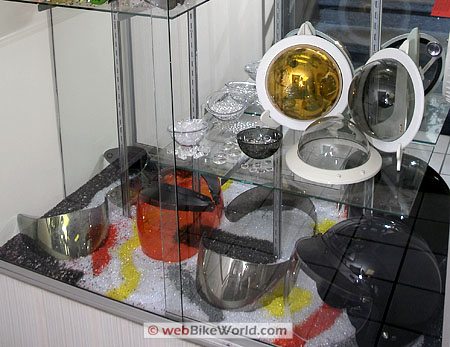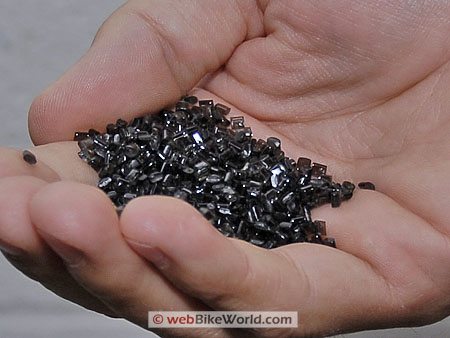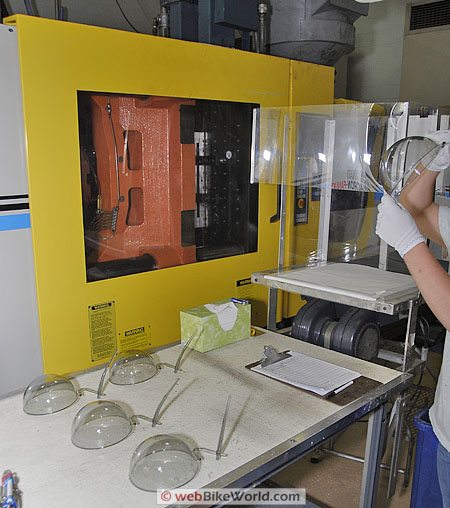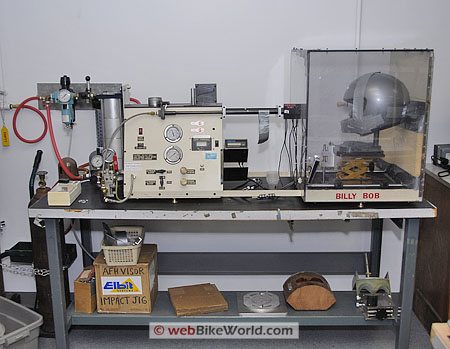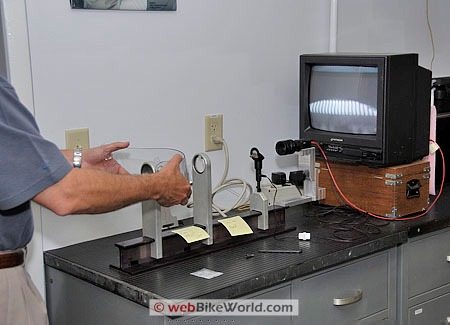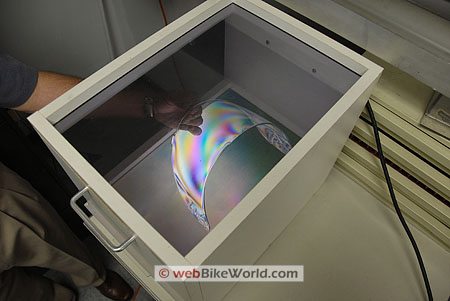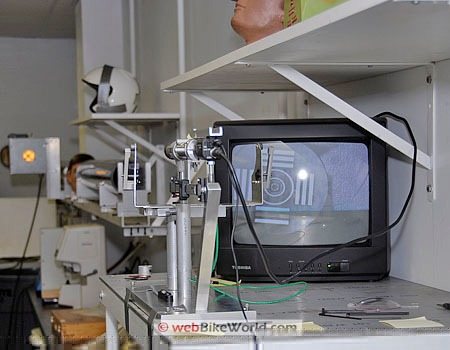A Visit to MXL Industries, Inc.
How do you make a motorcycle helmet visor? It’s easy.
First, buy a 50,000 square foot factory.
Next, fill it with a zillion dollars worth of injection molding machines, robots, inspection equipment and raw materials.
Then add a highly skilled and experienced staff who know how to design the products, engineer the processes and make everything flow smoothly through the plant.
That’s all there is to it!
Of course, if the formula was that simple, anyone could do it. Well, almost anyone…
A visor adds a tremendous functionality to a motorcycle helmet, of course.
But unless it becomes fogged, frozen or splattered with bugs, it fades into the background of the rider’s consciousness, which is just as it should be. You look through a visor, not at it.
So I’ll bet there aren’t very many motorcyclists spending a lot of time thinking about how visors are made. Ask someone and they’ll probably tell you that a visor must be made in some type of a mold.
Maybe it somehow gets tinted, especially with one of those cool, color-changing iridium coatings.
Everyone agrees on one thing for sure though: when you open the box, the helmet better have a nice, new, shiny visor attached!
As is usually the case, there’s a lot more to making a high-quality visor than I ever imagined, as I discovered during a recent visit to MXL Industries in Lancaster, Pennsylvania. MXL is one of the largest manufacturers of OEM and aftermarket motorcycle helmet visors in the world.
They also have the dubious distinction of manufacturing some of the most widely used products in motorcycling, yet they’re probably one of the least-known companies in the industry.
For example, MXL manufacturers 50% of all of the OEM and aftermarket visors used by Shoei. The visors made in Pennsylvania are actually shipped back to the Shoei plant in Japan, as well as packaged for distribution in the U.S. under the Shoei label.
And by the way, MXL even exports products to China, which is a testament to the quality and the cost structure of their products.
I learned about MXL by accident while doing the background research for our recent review of theSunshift photochromic visor (review).
Apparently several companies had worked together to develop a true photochromic visor for the motorcycle market, but the visors are manufactured at the MXL factory.
The folks at Akuma Helmets, who are currently distributing the Sunshift visor, provided an introduction to Jim Eberle, the company’s young and dynamic President and Chief Operating Officer.
This may sound naive, but it had never occurred to me that motorcycle helmet visors were still made in the U.S.A., much less in Pennsylvania Dutch Country, not very far from my home.
Surely this was yet another industry that had long since been moved offshore?
So when I discovered that MXL is a world leader in the design and manufacture of motorcycle helmet visors (along with many other types of visors and optics for other industries), I just had to get a peek.
Jim responded positively and graciously to my bold request for a plant tour for a webBikeWorld article, and this is my report.
Now you may or may not know anything at all about how visors are made, but I found it extremely interesting and I learned a lot during the extensive tour.
Note that MXL has some very sophisticated, proprietary and state-of-the-art design and manufacturing processes that have been developed in-house, so some of the very cool secrets will have to remain unspoken.
But I was able to take some photographs that we’ll get to in a minute so that you can also have a virtual plant tour.
Flow Coating
But first, there is one interesting myth that was busted during my visit, and I’m sure it will interest you too.
I had always assumed that it was the plastic itself (or, more accurately, the polycarbonate) that was imbued with the photochromic properties that allowed the visor to change from light to dark and back again in the presence of ultraviolet light.
But the photochromic effect actually comes from a coating that is applied to the surface of the visor.
I also thought that visors were tinted by dipping them in some type of dye or solution. In fact, this method may still be used for some of the inexpensive and low quality visors.
But MXL Industries specializes in the highest quality optics, which meant that they had to perfect various unique methods for applying the photochromic material while maintaining the high levels of quality demanded by their customers.
One of the techniques used for adding a treatment to a visor is called “flow coating”. In this process, the visor or part is moved through the liquid coating.
This is different than applying the coating with a spray, where the part is usually kept stationary while the spray head moves over the surface.
Flow coating has several advantages over dipping. The tight tolerances that must be held for the very thin layer of the coating can be more precisely controlled, without the runs or drips that can occur with dipping.
Also, the optical qualities of the visor are more likely to remain closer to the desired characteristics if the coating can be applied in a super-thin, controlled flow process.
But here’s the best part: the combination of various coating techniques used by MXL can create a visor with dissimilar coatings on the inside or the outside, depending upon the customer requirements.
For example, MXL can manufacture a visor with an anti-fog coating on the inside and a scratch-resistant coating on the outside. In fact, this is something they’re actually working on. And by the way, I’ve heard that the new anti-fog coating they’re using is outstanding, so we’re hoping to get one as soon as possible for an evaluation!
Of course, MXL Industries isn’t the only manufacturer that uses modern technologies to treat motorcycle helmet visors. But the trick is in applying the various coatings at a precise and uniform thickness over the entire compound surface of the visor, on the inside and the outside.
This is almost impossible to do by hand, so it takes a high-tech system that includes multi-axis robots and the complex software used to control them to get the job done right, which is MXL’s forte.
The Robots
Once the robots, the computers, the software, the processes and the production line have been designed and developed (obviously no easy task), the complex curvature of each visor must be mapped in three dimensions on both the inside and outside for the computer.
Then the multi-axis robot has to be programmed so it can guide the material over the surface of the visor, applying just the right type and thickness of coating.
MXL has developed a core expertise in this area, and their processes are used for visors and other coated optics for use in the motorcycle industry, military use, the medical industry and others.
MXL created a special production line for coating motorcycle helmet visors that does everything from removal of the sprue, (the extra material attached to the product that comes from the feed channels during the molding process) to cleaning the visors prior to coating, right on through to the coating process itself.
Once the visors leave the injection molding machine after they are first “born”, they’re placed into this production line and they are not touched by human hands again until the final inspection.
MXL also developed a very special (and very expensive!) process to create photochromic visors like the Sunshift.
The engineers are experienced in designing and developing custom techniques to manufacture and treat optics, so creating the photochromic line was right up their alley.
The Sunshift photochromic visors are the first of this type to reach the market, but several other brands will soon be available and they will be offered by the major helmet manufacturers and others.
These photochromic visors will probably all be manufactured by the special equipment and the new processes developed at MXL Industries.
By the way, in addition to the photochromic visors, MXL also makes tinted visors in many different hues; with anti-fog and anti-scratch coatings; and even chrome- and gold-plated visors that go through a vacuum deposition process.
They manufacture visors for firefighting equipment, respirators and super-high quality visors used by surgeons and fighter pilots.
The fighter pilot visor has very unique curvatures and shapes and it also has a special vacuum deposited coating on the inside that allows the pilot’s Heads-Up Display (HUD) and eye tracking devices to function.
The Factory Tour
So let’s take a quick photographic tour through the plant!
The photos above are some of the visors and products manufactured at the MXL plant, including motorcycle helmet visors and their special 3-Snap Flip Shield (also available with photochromic coating), shown here with an orange high-definition coating.
The other products include domes for security cameras and samples of the polycarbonate beads that are melted and used in the injection molding machines.
More products include visors coated with precious metals, which go through a vacuum deposition process.
The colored goggles are designed for military applications where lasers are used and some clear respirator visors can just be seen at the top of the photo.
(Photo Above) Believe it or not, this is the raw material for a tinted visor. These are polycarbonate beads, which are available with varying luminous transmission properties, depending upon the customer’s requirements.
The beads are heated to a special melting point and then injected under tons of pressure into precision molds to manufacture the visors.
(Photo Above) The polycarbonate beads come in these large crates called “Gaylords”, which are moved by forklift. The Gaylords are stored in this special room, where they are placed on the blue pedestals.
The pedestals can be tilted as shown to allow the beads to pour out the bottom of the box and into the vacuum lines seen on the upper left.
The lines along the wall direct the beads to the appropriate injection molding machines.
(Photo Above) Here are some of the many different visor molds, shown on the right-hand side on the rack. The molds look like square boxes from the outside, but inside are the complex patterns used to create the visors and other optical devices.
The molds have to be very robust to withstand the very high pressures and temperatures used in the molding process.
The boxes on the left are “travelers” used to temporarily store the visors as they are moved from the injection molding process to the coating line.
(Photo Above) Here’s one of the many computer-controlled injection molding machines used to manufacture the visors. Molding the visors is a continuous process and a robot is used to remove the new visor from its mold.
The robot is the blue arm over the top of the machine, just above the “Cincinnati Milacron” label, to the left of the Operator.
(Photo Above) Here’s a close-up of the injection molding machine. The orange structure that holds the mold can be seen behind the door.
Brand-new security camera domes can be seen on the table, hot from the mold, with the sprue left over from the molding process still attached.
Each visor or product is inspected multiple times, by the Machine Operators and the Quality Control personnel, who also use various inspection tools seen in the following photos.
(Photo Above) This is one of the vacuum deposition chambers (center right) used for precious metal coatings like gold, silver, iridium and more. The computer that controls the process can be seen on the left.
(Photo Above) The motorcycle helmet visors go through a variety of tests, including the selection of random samples that are placed on the helmet in “Billy Bob” for impact testing.
Pellets (see next photo) are launched at the visor at specified speeds to determine impact resistance.
(Photo Above) These are the different types of pellets used to fire at the visor for impact testing.
(Photo Above) The visors are put through a variety of tests to determine if they meet clarity and acuity specifications.
(Photo Above) This simple light polarizing box shows the stress levels in the molded plastic. This visor displays normal stress levels, with some slight stress where the lines come close together towards the upper edge of the visor.
(Photo Above) This is another type of acuity tester; the camera in the foreground reads a target in the distance. The target is displayed on the TV screen and a micrometer reading tells the QC inspector if the visor passes the test.
(Photo Above) Here’s another type of computer-controlled testing machine that tests the visors to ensure they meet the standards for light transmission and haze levels.
(Photo Above) This box is used for the special abrasion resistance test required for motorcycle helmet visors meeting the European ECE standard.
Conclusion
I hope you enjoyed learning about motorcycle helmet visors and how they are manufactured. It gives me a greater appreciation for everything that’s involved and I’ll never take a visor for granted again!
Thanks very much to the kind folks at MXL Industries, who so graciously opened their doors for the benefit of webBikeWorld visitors!
Publication Date: May 2007
Owner Comments and Feedback
See details on submitting comments.
From “B.K.” (August 2012): “Thanks for the “inside” tour of MXL Industries. As a mechanical engineer by profession and as a guy who just likes to know how to do things (and hence a fan of History Channel’s “Modern Marvels” and “How It’s Made” on the Science Channel), I enjoyed learning a little something extra today.
Next on the “to read” list is the “Making a Nolan Motorcycle Helmet” article.”


